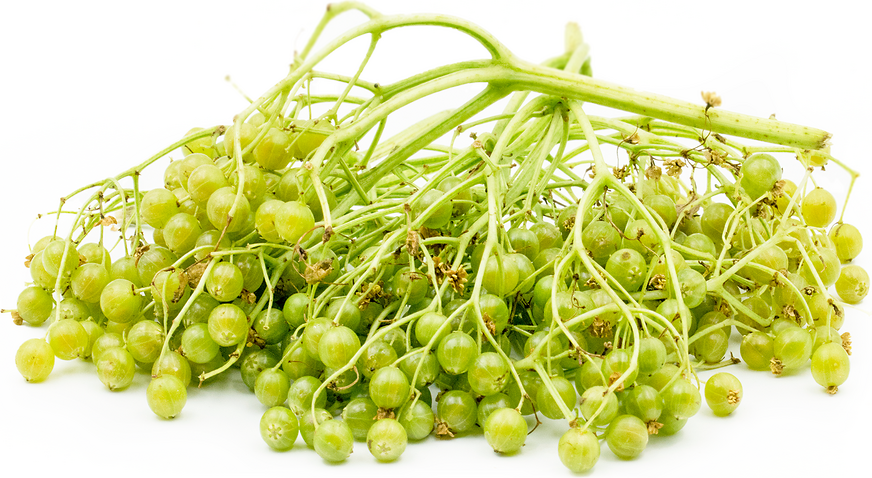


White Elderberries
Estimated Inventory, bskt : 0
Description/Taste
White elderberries are small fruits that grow in loose clusters on deciduous shrubs. They have a circular to ovate grape-like shape that measures about 5 millimeters in diameter. Their skin is a pale yellow-white to green-white hue with a translucent quality. It is glossy, smooth, and firm to the touch. White elderberry flesh contains soft seeds and has a juicy consistency. These fruits are somewhat astringent but sweeter than black or blue varieties. White elderberries have a slightly sour flavor with notes of gooseberry and white currants along with an herbal grassy finish.
Seasons/Availability
White elderberries are available from late summer to fall. They may also be available during the spring in tropical regions.
Current Facts
White elderberries are botanically classified as Sambucus gaudichaudiana and belong to the Adoxaceae family. The elderberry species have fruits that come in white, blue, black, and red. White elderberries are native to Australia where they are also known as Australian Elder or White Eldergreen. Most elderberry species grow on trees, but the White variety thrives on small perennial shrubs that reach up to two meters in height. These shrubs die back in the fall and sprout anew each spring. They are widely regarded as ornamental plants because they bloom large bunches of aromatic white flowers during warmer seasons. Elderberry fruits have been used as food for Indigenous Australians as well as for birds that disperse the fruit's seeds.
Nutritional Value
White elderberries are a good source of vitamins A and C. These vitamins encourage healthy vision, iron absorption, immune health, blood pressure reduction, protection from UV rays and free radical cell damage, and white blood cell, collagen, and serotonin production. These berries also provide the body with calcium to support bone and teeth strength, muscle and nerve function, and blood clotting. They contain thiamine that helps the body convert carbohydrates into energy and promote heart and brain function. White elderberries have niacin that breaks down fats and proteins, improves circulation, and helps reduce cholesterol levels.
Applications
White elderberries are most often consumed raw but can also be cooked, preserved, or dried. They have a richer sugar content than other colored varieties which may make them better for fresh eating or using in fruit salads. Juice from White elderberries can be cooked down into a sweetened syrup. This syrup may be poured over pancakes, waffles, ice creams, and yogurt parfaits. These fruits may also be preserved for jellies, compotes, and chutneys or incorporated into baked goods like pies, crisps, and muffins. White elderberries may be used to make wines, cocktails, juices, and smoothies. Sauces made from these berries complement savory foods like steak, turkey, stuffing, mashed potatoes, and roasted chicken. The fruits can be dried and tossed into granolas, grain bowls, salads, and herbal teas. White elderberries pair well with stone fruits, roasted nuts, vanilla, white wines, tawny ports, lavender, citrus, and fresh bramble berries. They should be loosely sealed in a container and stored in the refrigerator where they will last about 2 days.
Ethnic/Cultural Info
White elderberries grow wild all across damp sheltered areas of Australia. They are particularly common in the Dandenong Ranges. This is a mountainous region of Southeastern Australia that's part of the ancestral lands of the Wurundjeri people. These Indigenous nomads have lived in the area for over 35,000 years. They sustained themselves by collecting various foods from the forest including tubers, fruits, and likely White elderberries. The Wurundjeri people also hunted animals such as possums, lizards, koalas, wombats, birds, and kangaroos. During the mid-19th century, they traded bird tail feathers with European explorers who visited the area. Today, the rich cultural heritage of the Wurundjeri people and their deep connection to the land continue to be celebrated by locals and tourists who visit the region.
Geography/History
White elderberries are native to the Victoria region of Southeastern Australia. They flourish in temperate and subtropical climates. These berries grow wild in dry forests, coastal regions, along roadsides, in marshes, by canal banks, and in thickets. White elderberries have mainly spread from their original area through their underground root system. They can also be easily propagated from seed, making them suitable for sowing in home gardens. Despite their ease of cultivation, White elderberries are a rare fruit that is not often found outside of Australia. They are most commonly sourced through foraging in the Dandenong Ranges, the Otways, Southeastern Queensland, Eastern New South Wales, Southern Victoria, and Tasmania.
Podcasts




